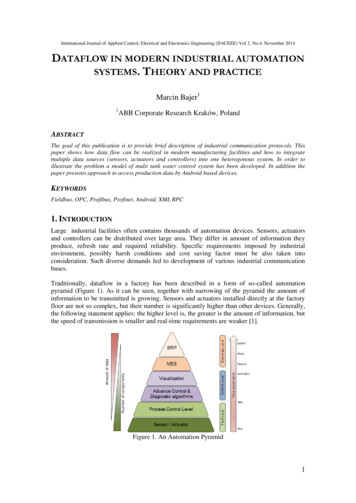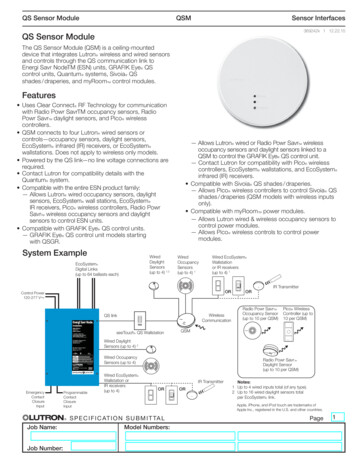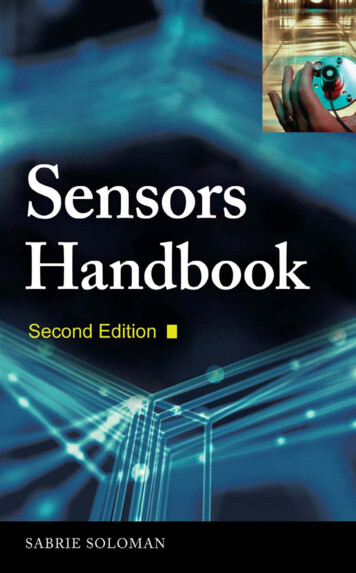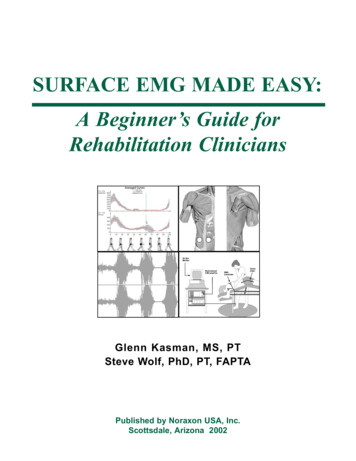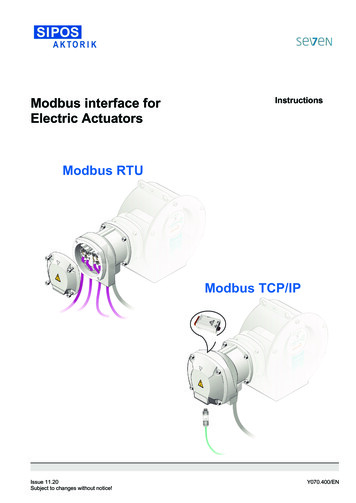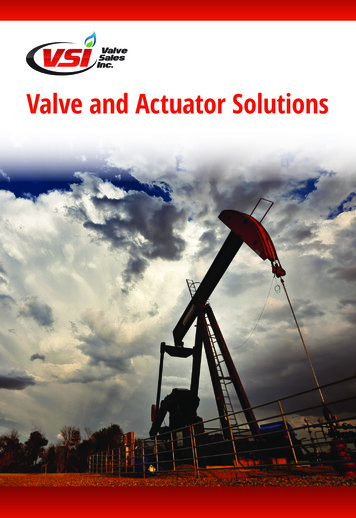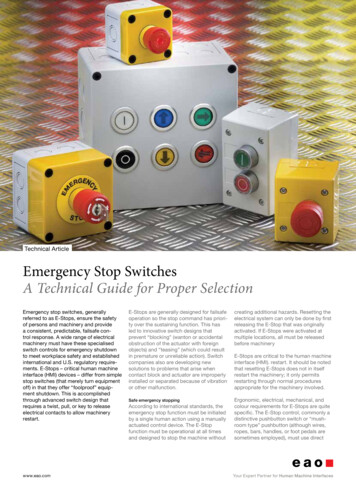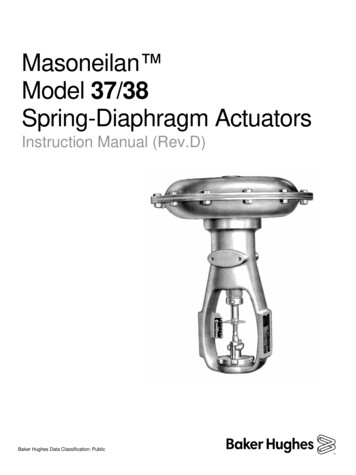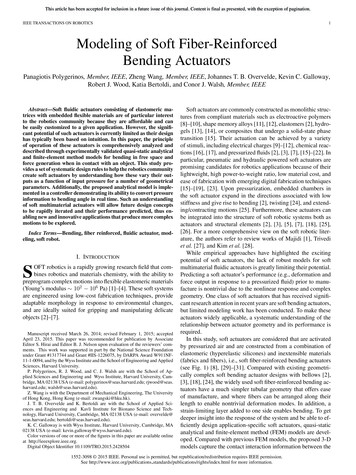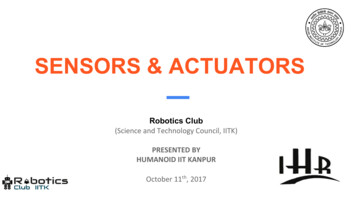
Transcription
SENSORS & ACTUATORSRobotics Club(Science and Technology Council, IITK)PRESENTED BYHUMANOID IIT KANPUROctober 11th, 2017
WHAT ARE WE GOING TO LEARN !! COMPARISON between Transducers Sensors And Actuators. Brief description About Sensors, Types of Sensors, Classifications . Actuators and it’s working. COMPUTER PROCESS CONTROL SYSTEM. Analog To Digital Convertor. Sampling ,Quantization, Encoding.
TransducerAny device that convert one form of energy to another.
SensorsDevices that measures physical quantitiesand convert them into signals which can beread by instruments
ActuatorsDevices that actuates or moves something.More specifically, they convertsenergy into motion or mechanical energy
SENSORS
Classification of SensorsIn passive sensing, sensor measures the energy that is naturally available, such as thermalinfrared, surface emissions.In active sensing, sensors provides energy on their own as a source of illumination. The energyreflected by the target is detected and measured.Note: The above two terms are used with the perspective of remote sensing.Source:http://wtlab.iis.u-tokyo.ac.jp/ wataru/lecture/rsgis/rsnote/cp2/cp2-1.htm
Active vs. Passive SensorsActive SensorPassive Sensor
What makes a good sensor? Precision: An ideal sensor produces same output forsame input. It is affected by noise and hysteresis. Resolution: The ability to detect small changes in themeasuring parameter Accuracy: ‘It is the combination of precision,resolution and calibration.’Source: -calibrate
Calibration of SensorsMost sensors are not ideal and are often affected by surrounding noise. For acolor sensor, this could be ambient light, and specular distributions.If a sensor is known to be accurate, it can be used to make comparison with referencereadings. This is usually done with respect to certain standard physical references, suchas for a rangefinder we may use a ruler for calibration.Each sensor has a ‘characteristic curve’ that defines the sensor’s response to an input.The calibration process maps the sensor’s response to an ideal linear response
Characteristic Curve of SensorSuppose the output of a sensor for some physical quantity x(t) is given by f(x(t)): Linear Model, where Affine Model, where ,Often, ‘a’ is called the proportionality constant, which gives an idea of thesensitivity of the sensor, and ‘b’ denotes the bias.Note: The sensitivity of a sensor is ratio of output value to measured quantity.
Sensor’s Operating RangeIf the operating range of a sensor is (L, H),To get an idea of how precise the measurements of a sensor can be, one defines itsprecision ‘p’ as the smallest difference between two distinguishable sensor readingsof the physical quantity.
Sampling and QuantisationThe process of the discretization of the domain of the signal being measured iscalled sampling, whereas quantization refers to the discretisation of the range.Pulse Code ModulatorContinuous-timecontinuous amplitudeinput signalDiscrete-timecontinuous amplitudesignal (PAM)Discrete-timediscrete amplitudesignal (PCM)Digital bit streamoutput signal
Sampling and QuantisationSAMPLING: Evaluating the input signal at discreteunits of time, say 0, T, 2T, . nT.QUANTIZING: Provides discretized values to theinput on basis of a finite number of thresholdingconditionsENCODING: Transforms the digital data into adigital signal, comprising of bits 0111011 , on basisof various schemes.Manchester Line code
Sampling and Quantisation If the sampling rate isn’t high, one can end up with different signals(aliases) duringreconstruction, that fit the same set of sample points. This is called aliasing, and isundesirable. For best sampling, the sampling rate must be 2 times the frequency ofthe signal. (Nyquist Shannon Sampling Theorem) In the case of quantisation, selection of fewer levels of discretisation can lead toprogressive loss of spatial detail. Also, contours(artificial boundaries) can startappearing due to sudden changes in intensity. For audio signals, this can be heard asnoise/distortions.
VARIETIES OF SENSORSAcoustic SensorsGeophoneHydrophoneMicrophoneAutomotive SensorsAir flow meterSpeedometerHall-Effect SensorAir- Fuel Ratio meterElectric Current SensorsHall ProbeMagnetometerCurrent sensorVoltage DetectorProximity SensorInfrared sensorUltrasonic sensorNavigation InstrumentsLIDARGyroscope RotaryEncoder OdometerTachometerOptical SensorPhotodiodeInfrared sensorCamera
1. CameraVision processing requires a lot of RAM, and even low resolution cameras maygive lots of data, parsing through which can be difficult.Cameras draw in around 0.1 A current, the current rating of the USB hub to which theyare attached must be checked.AdvamotionRaspberry PiCamera
2. Inertial Measurement Unit Consists of three sensors:oAccelerometer: Used to measure inertialaccelerationoGyroscope :Measures angular velocityabout defined axiso Magnetometer : Can be used along withgyroscope to get better estimates of robot’sorientation (i.e. roll, pitch, yaw)
3. Photo-resistorsLight sensitive resistors whose resistance decreasesas the intensity of light they are exposed toincreases. They are made of high resistancesemiconductor material.When light hits the device, the photons giveelectrons energy. This makes them jump into theconductive band and thereby conduct electricity.
4. Infrared Sensor IR led is led that emits light in IR region and can't beseen by the eyes.Photodiode is a type of diode which works inreverse bias and its resistance is changed whensubjected to change in light intensity.They are used for colour detection etc.
5. Flex SensorsMeasure the amount of deflection caused bybending, also called bend sensors.The bending must occur around a radius ofcurvature, as by some angle at a point isn’teffective and if done by more than 90 deg.,may permanently damage the sensor.
6. Ultrasonic SensorThese are commonly used for obstacle detection.Works on principle similar to that of Sonar whichconsists of time of flight,the Doppler effect and theattenuation of sound waves.
7. Rotary EncoderThey convert the angular position of ashaft or axle to aanalog / digital code.They may represent the value inabsolute or incremental terms. Theadvantage of absolute encoders is thatthey maintain the information of theposition even when power is removed,and this is available immediately on itsapplication.
8. Touch SensorTouch sensors can be defined asswitches that are activated by thetouch.Examples includes capacitancetouch switch, resistance touchswitch, and piezo touch switch.
9.Thermocouple Converts thermal energy intoelectrical energy and is used tomeasure temperature.When two dissimilar metal wiresare connected at one endforming a junction, and thatjunction is heated, a voltage isgenerated across the junction .
ACTUATORS
TYPES OF ACTUATORSIn a robot, actuators are used in order to produce some mechanical cal deviceswhich allow movementthrough use of electricallycontrolled systems of gearsTransforms energy storedin reservoirs intomechanical energy bymeans of suitable pumpsUses pneumatic energy providedby air compressor and transforms itinto mechanical energy by meansof pistons or turbinesDC MotorWater Pump byTefulong Ltd.Pneumatic cylinderby Janatics Ltd.
ACTUATOR FUNCTIONAL DIAGRAMUnregulatedPower Supply(from batteries)Control Signal(from microcontroller)H-BridgePowerAmplifier andModulationEnergyConversionActuatorMotor DriverOutput
MOTOR DRIVER Microcontrollers, typically, have current rating of 5-10 mA, while motors draw a supplyof 150mA. This means motors can’t be directly connected to microcontroller. For electromechanical actuators, following motor drivers are often used:oSimple DC Motors: L298, L293oServo Motors: Already have power cable and different control cableoStepper Motors: L/R Driver Circuit, Chopper DriveL298N Stepper Motor Driver Controller
L298 DUAL H-BRIDGE IC Allowstoindependentlycontroltwo DC motors up to 2 A each inboth directions. Power consumption for logical part0-36 mA Requires protective diodes againstback e.m.f. externallyConnections to L298 Dual H-Bridge 2A
H- BRIDGEIt is an electronic circuit used to apply voltage across a load in either directionon basis of input from a microcontrollerS1S2S3S4Result1001Motor moves right0110Motor moves left0000Motor coasts0101Motor brakes1010Motor brakes1100Short circuit0011Short circuit1111Short circuit
SPEED CONTROL USING PWM PulseWidth Modulation(PWM) is scheme in whichduty cycle of square waveoutputfromthemicrocontroller is varied byproviding a varying averageDC output Voltage seen by the load isdirectly proportional to theunregulated source voltage
Components of a System Hardware
Components of a System HardwareInput SignalTo plantPlant(Physical World)ActuatorsControlEffortOutput SignalFrom plantSensorsController(Digital World)MeasuredPlant Output
Data Handling SystemsBoth data about the physical world and control signals sent to interact withthe physical world are typically "analog" or continuously varying quantities.In order to use the power of digital electronics, one must convert fromanalog to digital form on the experimental measurement end and convertfrom digital to analog form on the control or output end of a laboratorysystem.
Data Collection after ControlSource: l
(Science and Technology Council, IITK) PRESENTED BY HUMANOID IIT KANPUR October 11th, 2017. WHAT ARE WE GOING TO LEARN !! COMPARISON between Transducers Sensors And Actuators. Brief description About Sensors, Types of Sensors, Classifications . Actuators and it's working.
